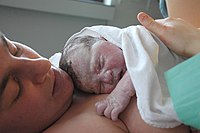
Photo from wikipedia
Objectives Fear of childbirth is common during pregnancy and may contribute to several adverse outcomes. We aimed to investigate childbirth fear and associated factors in a sample of pregnant Iranian… Click to show full abstract
Objectives Fear of childbirth is common during pregnancy and may contribute to several adverse outcomes. We aimed to investigate childbirth fear and associated factors in a sample of pregnant Iranian women. Methods This cross-sectional study was conducted on 525 pregnant women in Sabzevar, Iran from December 2016 to March 2017. The Wijma Delivery Expectancy/Experience Questionnaires (W-DEQ) was used to investigate fear of childbirth. Results The mean W-DEQ score was 67.6±23.5. Of 525 women, 19.6% and 6.1% experienced moderate (mean W-DEQ score ≥ 85) and severe (mean W-DEQ score ≥ 100) fear of childbirth, respectively. W-DEQ scores were not different in the categories of gestational age, parity, maternal age, educational level, body mass index, and employment status (p > 0.050). The mean score of childbirth fear was significantly higher in multiparas who preferred cesarean in comparison to those who preferred vaginal delivery (p < 0.032). The mean score of childbirth fear was significantly higher in nulliparas with a lower family income compared to those with a higher family income (p < 0.011). In nulliparas, predictors of moderate and severe childbirth fear were women's description of their present pregnancy (odds ratio (OR) = 2.600; 95% confidence interval (CI): 1.323-5.112), and receiving a low level of emotional support from their husband (OR = 4.450; 95% CI: 1.349-14.674), respectively. In multiparas, predictors of childbirth fear were unwanted pregnancy (OR = 2.930; 95% CI: 1.549-3.541), experiencing moderate to severe dyspareunia in the first intercourse (OR = 2.829; 95% CI: 1.479-5.414), having a low level of physical activity (OR = 1.942; 95% CI: 1.014-3.716), and perceived a low level of health (OR = 3.415; 95% CI: 1.172-9.950). Conclusions We observed a relatively high prevalence of childbirth fear in pregnant women in Iran. Interventions should be implemented in high-risk women considering psychological variables.
Journal Title: Oman medical journal
Year Published: 2018
Link to full text (if available)
Share on Social Media: Sign Up to like & get
recommendations!